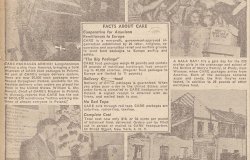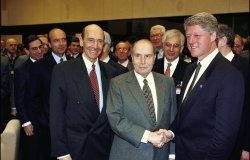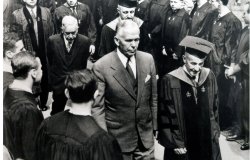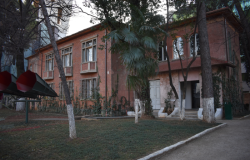
A blog of the History and Public Policy Program
How the Vietnamese Began to Remember a Forgotten War
Tracing shifts in the commemoration of the 1979 Sino-Vietnamese War, Martin Grossheim argues that Vietnamese veterans are playing an increasingly important role in shaping historical memory of the conflict.

Photograph by Martin Grossheim
When I visited the Vietnamese Museum of Military History (Viện Bảo tàng Lịch sử Quân sự) in Hanoi in 2015, I was struck by its detailed presentation of the First and Second Indochina Wars. Photographs, arms and other artefacts, and propaganda videos celebrate the “heroic and just struggle against French colonialists, the American imperialists and the South Vietnamese puppet army.”
A rather remote, dilapidated and less frequented exhibition room with the sign “Military History of Vietnam in the Period of Reconstructing and Defending the Country, 1975–2011” was reserved for the last war Vietnam has fought so far: the war against China (1979–1989). The exhibition avoided the term “war” (chiến tranh), however, and even managed not to mention “China” (Trung Quốc) as the aggressor. Besides displaying a number of historical items such as weapons and uniforms, it showed 11 rather blurred pictures of battle scenes and a visit that a student delegation from Hanoi University paid to the battle front at the border in March 1979.

Photograph by Martin Grossheim
When I went to the museum again a few years later in July 2019, things had changed: the rather sordid exhibition hall had been completely renovated. A brand-new exhibition now celebrates the heroism of the soldiers, militia, and civilians who fought against China from 1979 through to the end of the 1980s. It highlights the feats of heroic martyrs such as Lê Đình Chinh, for example – the first Vietnamese soldier to sacrifice his life at the northern border during a skirmish with Chinese provocateurs in Lạng Sơn on 25 August 1978.
Despite its heroic tone, the exhibition still consistently avoided using the term “China.” The texts on the wall charts used the phrase “the northern border” (biên giới phía Bắc) instead of identifying the adversary, along with the unspecific terms “địch” and “thù” (enemy).

Photograph by Martin Grossheim

Photograph by Martin Grossheim
Despite the taboo words still being observed, it was obvious that the exhibition on the war against China had been upgraded upon orders from the authorities in Hanoi – probably the Department of Propaganda and Education (Ban Tuyên Giáo Trung ương) as that is in charge of running the “memory machine” of the Vietnamese Communist Party.[i] But what exactly had happened?
The Shift in the Commemoration of the Sino-Vietnamese War
In the 1980s, relations between Hanoi and Beijing were at a low ebb. In Vietnam, museums, history textbooks, films, and songs presented the attack in February/March 1979 as a Chinese invasion. The Museum for US War Crimes in Ho Chi Minh City, for example – later renamed The War Remnants Museum – ran a special exhibition in 1988 that displayed war crimes that the “Chinese expansionists” had committed in 1979 in grim detail. When I returned to the museum in 1992, the exhibition room was still there, but it was empty – the pictures of Chinese war crimes had all been removed – and I was even told that there had never been an exhibition there on Chinese war crimes.
This sudden shift in the official commemoration of the war against China was due to the official normalization of Sino-Vietnamese relations in November 1991. In the following years, memory of Vietnam’s war with its northern neighbour almost fell into oblivion. When anniversaries of the war occurred, state media did not celebrate or acknowledge them.
Furthermore, any journalists or other independent groups who dared to commemorate the war were censored and got into trouble. An article that the journalist Huy Đức had written on the 30th anniversary of the war on the Sài Gòn Tiếp Thị website on 9 February 2009 was removed after just a few hours.[ii] Not only had Huy Đức dared to mention the forgotten war, but he had even revealed the huge losses that the Vietnamese People’s Army (PAVN) had suffered at the battle of Vị Xuyên in Hà Giang province (formerly Hà Tuyên) in the mid-1980s. On top of that, he remarked at the end of the article that the war had fallen into oblivion since then, meaning the Vietnamese state had chosen not to commemorate it and keep it in people’s minds.
The almost complete removal of the war against China from official commemorations ended a few years later, however. This happened against the backdrop of assertive Chinese actions in the South China Sea. The year 2014 constituted a turning point in the commemoration of the war, when the People’s Republic of China moved a Chinese oil rig to waters near the disputed Paracel Islands in the South China Sea, not only did mutual relations deteriorate and anti-Chinese protests flare up all over Vietnam, but many Vietnamese also started to show a greater interest in past military clashes with their northern neighbour.
This led some Vietnamese citizens to criticize the inadequate coverage of the war in history textbooks used in schools. Historians joined in and demanded an overhaul of the school textbooks. Vietnamese state media increasingly addressed the Sino-Vietnamese War at the same time. Vietnamese TV channels, for example, began to broadcast documentaries about the war.
On the occasion of the 40th anniversary of the war in 2019, the Vietnamese authorities commemorated the event at length. However, compared with the celebration of the victory against the Khmer Rouge (1979) in the same year, it is obvious that the authorities wanted the anniversary of the Sino-Vietnamese War to pass with a relatively low profile. While a huge official ceremony was held in commemoration of the 40th anniversary of the victory against the Khmer Rouge with the participation of the entire Party and state leadership, only a small meeting was organized to commemorate the war against China. This event was staged by the Vietnamese Ministry of Labour, Invalids and Social Affairs in conjunction with other ministries and the Fatherland Front.
In the same vein, the Vietnamese Association of Historians (Hội Khoa học Lịch sử Việt Nam) and the Vietnam Academy of Social Sciences jointly organized a national conference in January 2019, which presented a “sanitized” version of the war. The conference was entitled “The Struggle to Defend the Northern Border of the Country – Looking Back after 40 Years” and presented Vietnam’s ten-year-long military conflict with the People’s Republic of China as a “military fight (chiến đấu),” not as a war (chiến tranh).
This interpretation was, in fact, completely in line with the guidelines on the celebration of the anniversary set by the Central Department of Propaganda and Education .[iii] Articles in the state media claimed in a rather apologetic tone that the VCP and the Vietnamese state had never forgotten the war and had always cared for veterans, war invalids, and the families of martyrs. All this suggests that the state and the VCP have continuously tried to monitor and control the commemoration of the war with China.[iv]
Vietnamese War Veterans as “Agents of Remembrance”
Over the last few years, however, non-state “agents of remembrance” such as war veterans have actively shaped the commemoration of the war against China, not just the “memory machine” run by the VCP. These former soldiers benefitted from the commemorative turn of 2014 and contributed to it at the same time.
Veterans who once fought on the battlefield of Vị Xuyên played an especially important role here – this combat zone was a site where bloody clashes with Chinese troops occurred repeatedly between 1984 and 1989. The “war to defend the country against encroachment at the northern border” (Chiến tranh bảo vệ tổ quốc chống lấn chiếm biên giới phía Bắc), as many veterans call the Chinese occupation of the remote mountainous area, largely fell into oblivion over the years, but they kept the memory of it alive in their own way.
Since Vietnamese state media continued to keep silent about the war against China once it had ended, small groups of war veterans who had fought in Vị Xuyên began to return to the former battlefield to commemorate their fallen comrades themselves. After 2010, more and more veterans from all over the country flocked to Hà Giang each July to commemorate the anniversary of the so-called MB84 campaign of 1984 – a major counteroffensive against Chinese forces that resulted in heavy losses on the Vietnamese side.
Many veterans became increasingly dissatisfied with the fact that there was no proper memorial site on the battlefield where they could make offerings to their fallen comrades. They also complained that the state had not made any serious effort to locate the remains of all the fallen soldiers, whose bones were still scattered around the old battlefield. When Major General Nguyễn Đức Huy and other commanding officers involved in the fighting in Vị Xuyên returned to the former battleground in 2013, they were shocked and upset to learn that the remains of just 20 or 30 fallen soldiers had been discovered on the battlefield after so many years (30 in all); approximately 2,000 soldiers who fell at Vị Xuyên are still unaccounted for.
Since the Vietnamese state had not paid enough attention to finding and burying the fallen soldiers, many of their surviving comrades took the initiative and started looking for them themselves. They even built a site of their own where they could commemorate the events in an appropriate way. They chose Peak 468 (điểm cao 468) in the middle of the old battlefield near the commune of Thanh Thủy as the location for the small memorial site. An incense burner was inaugurated in November 2013 as a first step. The whole project was financed by donations made by war veterans. As luck would have it, Trương Tấn Sang, then President of Vietnam, heard about the activities of the veterans of the battle of Vị Xuyên and invited veterans’ representatives to his office for a talk. He consequently promised to support the veterans’ plans to recover the remaining bodies.
As a result, the veterans were able to enlarge the memorial site in Hà Giang and transform it into a more fitting war memorial (đài tưởng niệm). Furthermore, in May 2016, with official permission from the Vietnamese Ministry of Defence, around 20 mostly high-ranking officers involved in the battles in Hà Giang in the 1980s established the “Nationwide Liaison Committee of the Veterans of the Battle of Vị Xuyên – Hà Tuyên” (Ban Liên Lạc Cựu Chiến Binh Toàn Quốc Mặt Trận Vị Xuyên – Hà Tuyên), a body intended to serve the veterans as an official mouthpiece and help them promote their demands. The first meeting of the Committee was held in Hanoi in July 2016 and was attended by 600 delegates from all over Vietnam.
A month earlier, the memorial site known as Đài tưởng niệm 468 (“Memorial Site 468”) was inaugurated, just in time for the anniversary of the MB84 campaign, which is known as the “death anniversary of the campaign” (ngày giỗ trận) in Vietnamese. The inauguration ceremony was covered in a series of newspaper articles that not only reported on the event itself, but also on the almost forgotten war in Vị Xuyên.

Photograph by Martin Grossheim
All this happened as there was an upsurge in media coverage of the Chinese invasion of Vietnam in 1979. In recent years, the commemoration of the previously forgotten war in Vị Xuyên has continued to expand. During the 40th anniversary of the outbreak of the war against China in February 2019, the battles of the 1980s in Hà Giang saw unprecedented media coverage in Vietnam: a whole series of articles and documentaries about the war and interviews with veterans appeared in the Vietnamese state media.
At the same time, a special group in charge of tracing the remains of fallen soldiers in Hà Giang was finally established with financial support from the Vietnamese Ministry of Defence, more than 30 years after the end of the war. However, the fact that it took the Vietnamese state so long to start looking for the remains of its fallen soldiers at Vị Xuyên properly when it had tackled the same kind of task as soon as the First and Second Indochina Wars ended left a bitter aftertaste in the mouths of a good many veterans.
In July 2019, the veterans of Vị Xuyên celebrated the 35th “death anniversary” of the MB84 campaign. The same year Vietnam commemorated the 40th anniversary of the outbreak of the war against China in 1979.
The Vietnamese state and the VCP have “upgraded” their commemoration of the war, but still try to circumscribe it by keeping the memory of it relatively low-profile and presenting the war as a patriotic struggle for the defence of the fatherland without mentioning the aggressor specifically – the PRC.
The commemoration of history in Vietnam has become multivocal, however. It seems that 40 years after the end of the war, the veterans of the Hà Giang battlefield who “fought” to break the state-sanctioned silence for decades as agents of remembrance have achieved a victory on the commemorative front.

Photograph by Martin Grossheim
This posting is the preliminary outcome of a research project entitled “The Commemoration of the Sino-Vietnamese War in Vietnam (1979–1989)”. The author would like to thank the Department of Humanities, Seoul National University, for providing a generous grant from the Research Resettlement Fund for new faculty members, which made this research project possible.
[i] See the detailed analysis in Martin Grossheim, “Celebrating the Socialist Past: The Vietnamese ‘Memory Machine’ at Work”, in Journal of Humanities 77, no. 2 (2020): 327–356.
[ii] Huy Đức 2011, “Biên giới Tháng hai (2009–1979)” [The border in February (2009–1979)]. Facebook Osin HuyDuc, 15 February 2011. https://vi-vn.facebook.com/notes/truong-huy-san/bi%C3%AAn-gi%E1%BB%9Bi-th%C3%A1ng-hai-2009-1979/189934721029764/. Accessed on 7 July 2020.
[iii] Thái Bình 2019. “Cuộc chiến đấu bảo vệ biên giới phía Bắc: 40 năm nhìn lại” [The struggle to defend the northern border: looking back after 40 years]. T/c Cộng sản, 15 February 2019. http://www.tapchicongsan.org.vn/Home/Thong-tin-ly-luan/2019/54155/Cuoc-chien-dau-bao-ve-bien-gioi-phia-Bac-40-nam-nhin.aspx. Accessed on 11 April 2019.
[iv] Nguyễn Đức Độ 2019. “Cảnh giác với những luận điệu sai trái, lợi dụng cuộc chiến tranh biên giới phía Bắc để xuyên tạc, kích động chống phá” [Being vigilant about wrong allegations; misusing the war at the northern border to distort (and) incite subversion]. Tổ Quốc, 15 February 2019. http://toquoc.vn/canh-giac-voi-nhung-luan-dieu-sai-trai-loi-dung-cuoc-chien-tranh-bien-gioi-phia-bac-de-xuyen-tac-kich-dong-chong-pha-20190215092256847.htm. Accessed on 7 January 2020.
About the Author

Martin Grossheim
Associate Professor in Vietnamese History, Seoul National University

History and Public Policy Program
The History and Public Policy Program makes public the primary source record of 20th and 21st century international history from repositories around the world, facilitates scholarship based on those records, and uses these materials to provide context for classroom, public, and policy debates on global affairs. Read more

Cold War International History Project
The Cold War International History Project supports the full and prompt release of historical materials by governments on all sides of the Cold War. Through an award winning Digital Archive, the Project allows scholars, journalists, students, and the interested public to reassess the Cold War and its many contemporary legacies. It is part of the Wilson Center's History and Public Policy Program. Read more







